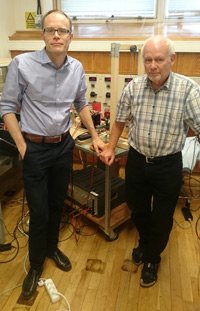KTH-based technology makes offshore wind power more accessible

Scibreak, a small startup company originating from the labs of KTH, has developed technology that can build a robust and reliable offshore power grid. This has caught the attention of industry giant Mitsubishi Electric.
Amid an increased investment in renewable energy sources such as wind and solar power. Extensive plans exist for expanding offshore wind power in, for example, the North and Baltic Seas. That will require significant upgrades to the infrastructure that will transport the offshore energy to land.
An Alternating Current (AC) cable cannot technically exceed 100 kilometres. This means a Direct Current (DC) cable must be used instead. A DC is rarely used in a primary network, only in single connections between two points in an existing AC network. But DC has become increasingly important as the power grid capacity is increasing.
“For offshore wind power, you have to use cables. It is impossible to use overhead lines as is often done on land,” says Staffan Norrga, Associated Professor at the Division of Electric Power and Energy Systems at KTH.
What has been missing are cost-effective technical solutions for developing a robust and reliable power grid. To build a network, you must have protective functions such as switches that can quickly isolate parts of the power grid if a fault should occur.
“DC has previously been difficult to break, but now we have the technology to do it cost-effectively. This is where Scibreak AB’s technology comes in,” says Norrga.

In 2014, Staffan Norrga, then a lecturer at KTH, and his partner Lennart Ängqvist, an adjunct professor, started with a basic idea they tested in a lab at KTH.
“As a small startup, it is quite challenging to develop this type of infrastructure and assert oneself against the prominent players in these industries,” says Norrga, “Being part of KTH was a great advantage.”
But once you become a commercial company, KTH can no longer host you. Since the end of 2015, Scibreak can be found in Kallhäll outside Stockholm, where they continue to develop a technology that can provide significant cost benefits, saves on equipment and provides better reliability.
Amid growth in green energy innovation, interest in this type of technology has increased sharply. Scibreak has a market-leading DC circuit breaker technology in terms of operation time and footprint. That makes Scibreak attractive to the primary energy players on the market. Through acquiring shares, Mitsubishi Electric will utilise Scibreak’s technology and know-how to lead the market commercialisation of DC circuit breakers and contribute to the realisation of carbon neutrality through the further spread of renewable energy.
“We in Sweden have a lot of green energy that many people are interested in. We hope this collaboration with Mitsubishi Electric will spur further development in this field,” concludes Norrga.
Contact:
